Tabasco Style Fermented Hot Sauce
August 21, 2014 | Updated June 06, 2022
As an Amazon Associate I earn from qualifying purchases.

I am a Tabasco man, always have been. Sure, I love lots of hot sauces, but for me the alpha and omega of pepper sauce is Tabasco. What I didn’t know until I visited their plant was that it is a fermented hot sauce.
This slow fermentation makes sauces like Tabasco something more than just heat and vinegar, something more refined and mellow. I had no idea what that something was until I got a chance to visit Avery Island, Louisiana, and meet the McIlhenny family face to face.
Touring the plant, I was shocked to learn that the recipe for Tabasco is not some closely guarded secret. They’ll gladly tell anyone who asks what it is: Tabasco peppers, 2 1/2 percent salt, vinegar… and time. Lots of time. Winemaker-style time. Tony Simmons, the company’s CEO, walked me through it.
The Tabasco chiles are chopped up, mixed with salt mined right from the island itself, then poured into old oak barrels to ferment in a barn for up to five years, although most of the mash is fermented only (!) three years.
They then mix the mash with distilled vinegar (they used to use white wine vinegar) and let this pickle for a month, mixing all the way. Finally, they strain out the pulp and seeds and bottle the sauce.
I was fascinated by this. Aged in oak? For three years?! Damn. Gauntlet thrown. One I will gladly pick up.
Two years later, here’s how it went.
I decided to not even try to replicate Tabasco Sauce exactly, because why would I want to? Even if I succeeded, I can buy the stuff easier at the supermarket. I’d use the method, with different chiles, to make my own fermented hot sauce. Rather, two sauces: One red, one green.
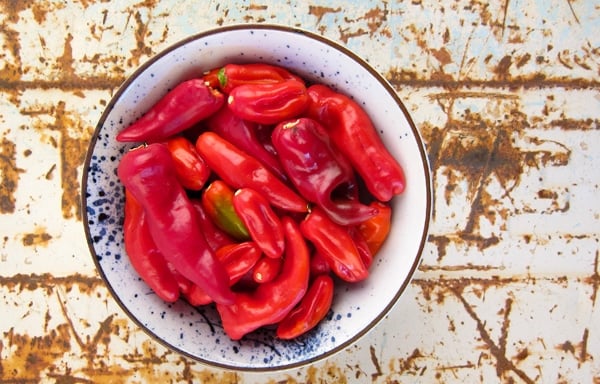
I grew a lot of chiles that year, so I used an eclectic mix of serranos, Tabascos, ripe padron chiles, and a few Thai chiles tossed in for good measure. Yes, I know doing this makes this sauce unrepeatable, but so be it. No vintage of a wine is exactly repeatable either, and since fermented hot sauce keeps almost as long as wine, it’d be fun to play with annual vintages.
I waited until late September 2012 to harvest all my chiles, and I grabbed both the red and green.
I stemmed them all and chopped them roughly, then tossed them in a food processor with that critical 2 1/2 percent salt — this is enough to protect the chiles from bad bacteria but not enough to prevent fermentation by the good bugs.
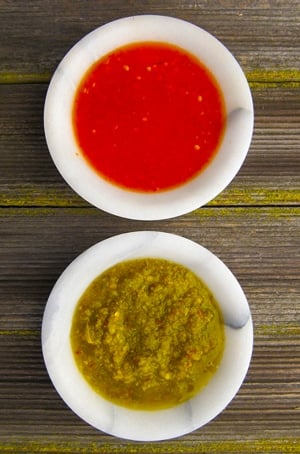
Into quart Mason jars they all went. Within a day they were fermenting, with an acrid, slightly yeasty smell that was something like a cross between Mace and a loaf of bread. Not that unpleasant, actually. I stirred the mash every day and let it breathe. After about 10 days things settled down, so I moved the jars into my salami fridge, which is a cool 55°F. But before I did that, I grabbed some toasted oak cubes I had from winemaking and tossed them in. Instant oak barrel!
And then I forgot about my hot sauce. For two full years. OK, that’s not totally true. Every few months or so I’d check on them, and once in a while a film of mold would grow on the surface; this happened three times. I just picked it off and called it good. After all, we’re dealing with chiles and salt here, both of which are pretty inhospitable ingredients to any truly bad wee beasties.
Finally, earlier this year I decided to make my sauce. I stared at that awesomely fermented mash, which was at once mellow and smooth yet muy picante, if such a thing can exist. I just couldn’t discard it. So I pureed it even smoother and added a little xanthan gum to stabilize it.
The result is a lovely hot sauce. Tangy from the fermentation, hot but not overbearing (a result of the mix of chiles I used), vinegary and a bit salty. It’s not Tabasco. It’s something different. Something… better? Perish the thought.
Fermented, Tabasco-Style Hot Sauce
Ingredients
- 3 1/3 pounds chile peppers, about 1.5 kilos
- 1 ounce kosher salt, about 37 grams
- 2 cups water
- 3 ounces oak cubes
- 4 cups white wine vinegar
- 1 teaspoon xanthan gum (optional)
Instructions
- Roughly chop the chiles and compost the stems. Blitz the chiles in a food processor or blender with the salt and water until you get a rough paste or slurry, depending on how much moisture there is in the peppers themselves. I keep the seeds in the chiles, but if you want a milder sauce, remove them.
- Put the mash into quart mason jars and cap them loosely. "Burp" the caps at least once a day to let out escaping gases and let air in. The chiles will ferment like this for at least a week, and sometimes up to 3 weeks. When the chiles settle down, add the oak cubes, distributing them evenly throughout the jars. Tighten the lids and store the jars in a cool, dark place. I kept mine in my salami fridge, which is 55°F. A basement is fine, as would a fridge. Tabasco keeps their mash barrels at ambient temperatures, which in Louisiana can top 100°F. I am working on a batch fermented this way now, and I see no reason it won't work. Don't let the mash freeze, however.
- Keep the mash like this no less than 3 months, and up to 2 years. When you are ready to finish the sauce, mix the mash with the vinegar.
- You now have two choices: You can do what Tabasco does and return the mix to the jars, shake them every day for a month and then strain out the pulp and seeds. Or, do what I do and keep all that pulp, which will give the sauce body and thickness. If you choose my method, you will need to really blend the sauce and stabilize it -- otherwise the sauce will eventually separate and will need to be shaken up before each use. To do so, dissolve the xanthan gum in 2 tablespoons of water and add it to the blender. Blend for a solid minute. Let the sauce rest for 1 hour before bottling so any trapped air in sauce (from the blending process) can escape. Bottle and store. The sauce will keep for a year or more.
Notes
Nutrition information is automatically calculated, so should only be used as an approximation.
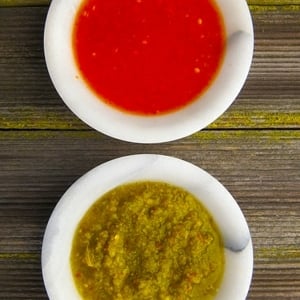

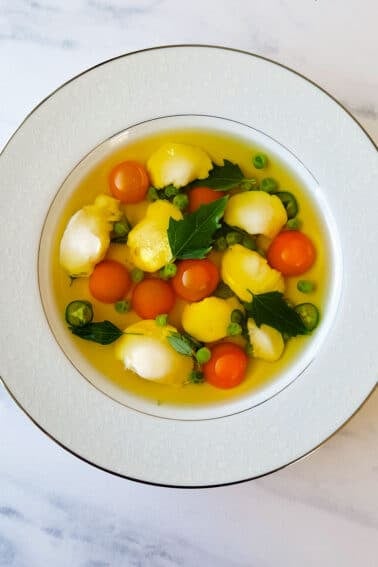

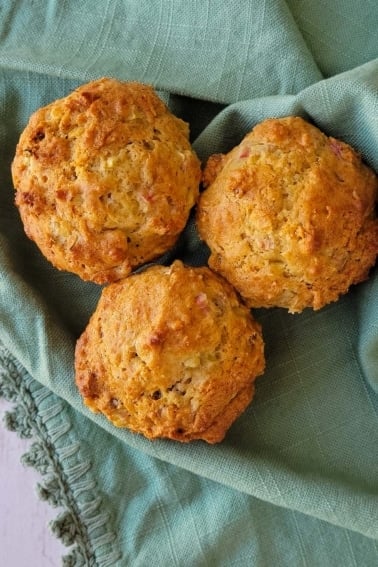
I would like to add another flavour can I add garlic to the mash then ferament
I’m going to try this today. I wanted to make it with my own peppers but didn’t produce enough.
By the way, you have great recipes and insight, it’s my go-to hot sauce site.
Thank you Hank Im a big fan of Tabasco as well. I’ve been giving some thougth in making a sauce similar to Tabasco and this is very useful information.sry i called you Frank lol my eyes are tired its 1:45 am over here in South Texas.
Dear Hank,
Thank you very much for your recipe. We live in Tuscany, Italy. I typically make a sweet and sour sauce for our table (thai style). This year we have 4 lbs of Chocolate habanero chiles from one isolated plant. We were stumped as to what to do with them as they are mighty hot! So, we are going to brew them up in Louisiana style and see how they turn out, I will keep you posted. Kind regards,
Malvin
Just got ours started today–green and red. We were blessed with a grocery bag full of variety peppers (jalapeno, cayenne, hot banana, thai, serrano and poblano that I know of) so this should be really awesome. Adding the oak cubes per your instructions and I expect the family to be very happy with their Solstice gifts. Thanks for all you do! Keep it up, and good luck hunting in Idaho!
Quick question – I’m fermenting some peppers per your instruction and every few days there’s a layer of mold, which I’ve been scrapping off. Having fermented other things, I know that can happen, but I just want to make sure it’s cool here or if there’s something I can/should do to keep this from happening.
Thanks for the great recipe!
Yep. It happens. It seems to die down after the initial ferment, when you can put it in jars.
My hubby grows peppers, mostly cayenne.
Last year, he planted some poblanos just for me (that’s love right there).
Unfortunately, they sucked the heat right out of the cayennes sitting next to them.
His recent obsession is with ghost peppers. He figures he’ll starve them of water so they get even hotter. He can really take the heat and will love your Rx here.
That sauce looks amazing! I think I’m going to give this a try.
Making some Hatch Green Chile sauce right now. Helping fermentation kick off by adding 1% kimchee juice.
I hope one day you can travel to the Tapa Tio factory and learn those secrets!
So much more of a fruitier, rounder flavor, IMO
Do you think it’s possible to add more peppers (as they ripen and become available from the garden) to the batch I started five days ago? Or should I just start a separate jar for each ripening period?
I bet that would work for a few weeks – it should lengthen the fermentation as the new peppers are added. Don’t forget the extra salt you’ll need!
Two Years! Four Quarts! Somehow I don’t think I’ll be making this, BUT I bet it is amazing stuff. Impressive.
Not to start a religious war, but have you ever tasted “Texas Pete”? It has nothing to do with Texas, comes from NC, but IMHO is superior to Tabasco. Perhaps you are like an old friend of mine who put Tabasco on everything, including dinner rolls 🙂
Of course I’ve tried Texas Pete! It’s fine, but I like Tabasco better.
This is something I definitely want to try this season. I’m working on a homemade granite metate y mano, so I’m confidant that I have the patience to wait a few years…
I’d probably omit the xanthan gum though. In very simple terms, Xanthomonas campestris, the same bacterium that causes broccoli rot, exudes ‘snot’ when fed a diet of corn syrup. The slime is dehydrated, pulverized, and used as an emulsificant and to keep particulates in aqueous suspension.
It’s now under suspicion for causing symptoms mistaken for gluten intolerance.
Huh. Good to know!
This will be my afternoon project. The brewing supply store here has oak chips rather than cubes. Do you think it makes sense to use less chips given that they will have more surface area than the cubes? Or will it matter that much?
Thanks
Yep. I’d use a little less. You can always add more down the road.
I believe that xanthan gum is a thickening agent. Hank explains in the article that to stabilize the sauce is to keep the pulp from separating from the liquid and if you don’t you will need to shake it before each use.
I’m curious where to purchase xanthan gum? I’m guessing it’s not found in your average grocery store, is it?
Weirdly, it is widely available now! It’s a prime ingredient in a lot of gluten-free baking. I’ve seen it in Whole Foods a lot. But a health food store will definitely have it, too.
I like the way you think. I’m aging a batch of green walnut catsup (tasting like worcestershire sauce) and have been pondering fermented pepper sauce now that peppers are piled high at the tailgates. Thanks for the formula and method. I think I’ll do it with cayennes and garlic.
Great post- my garden will provide.
Talk to us about the Xanthan gum. What do you mean when you say stabilize ? What would it be like without?
Damn Hank, this is amazing. i’m way too impatient to leave anything in the fridge that long – very impressive indeed!! I’ve made many a hot sauce in my day, but never fermented. Truly impressive. 🙂
Wow—awesome! I’ve done sriracha- and cholula-style sauces for a while, but this ups the ante. I’ll put in a few jars while hot peppers are popping, and… get back to you in a few years. 🙂
Wow this is serious stuff. I once made my own green Tabasco, but that was instant gratification, nothing like this. And I’m fascinated by those oak cubes, I have to get some and play.